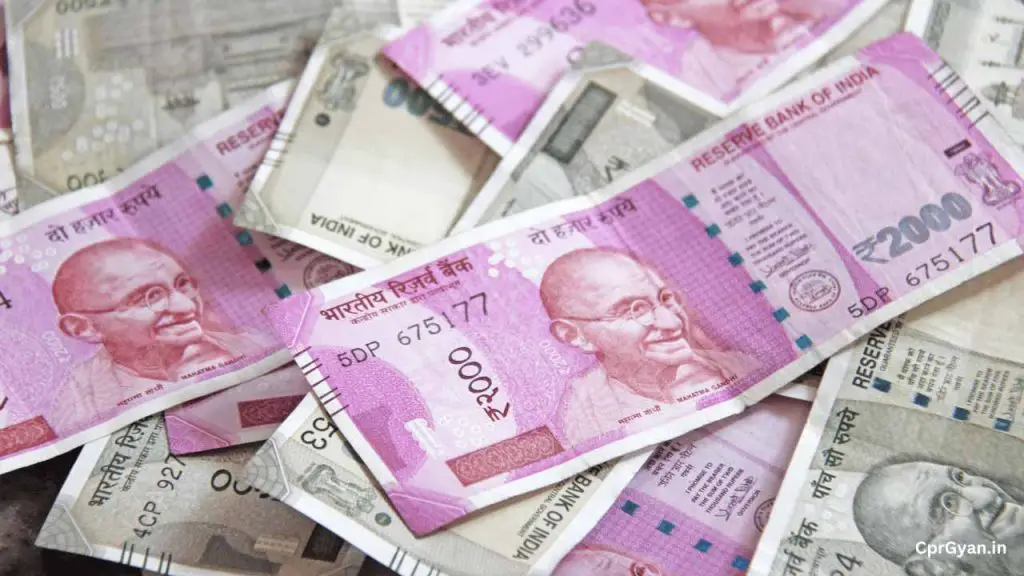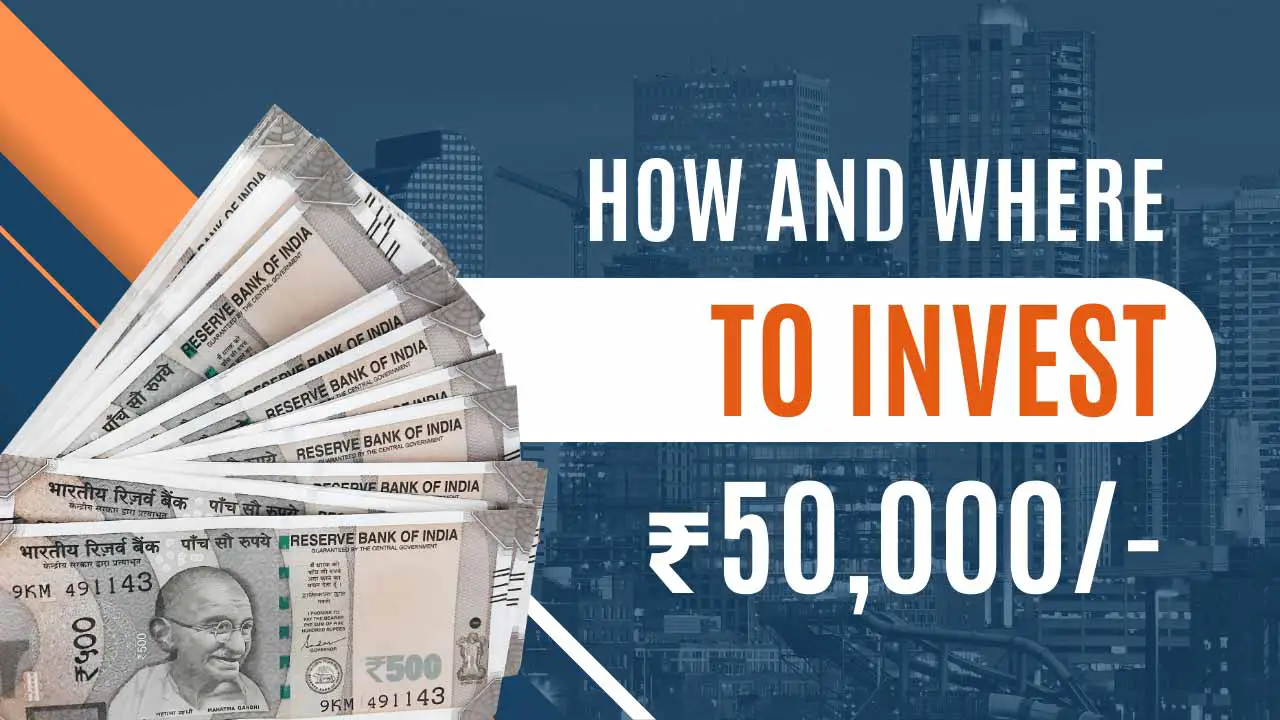You’ve got ₹50,000 burning a hole in your pocket. It’s a sum that could quickly vanish on a shopping spree or a lavish vacation. But what if I told you that this sum has the potential to grow exponentially, securing not just your future but possibly even your children’s?
What if I told you you have the golden ticket to becoming a stakeholder in the next big thing, be it an up-and-coming company or a breakthrough investment scheme? Now, that’s a compelling thought.
Your ₹50,000 is not just a number. It’s an untapped gold mine. It’s your chance to level up in financial literacy, where money doesn’t just sit; it grows, works for you, and multiplies like you wouldn’t believe.
Whether you’re a seasoned investor or an absolute beginner, looking to dive deep into the stock market, or are merely intrigued by the soaring returns of Peer-to-peer lending—there’s an array of opportunities waiting for you to sink your teeth into.
Also read: Best Financial Advisors in India
In this comprehensive guide, we won’t just talk numbers but about financial empowerment. From the social lending magic of Peer-to-peer systems promising up to a staggering 20% ROI to good old fixed deposits that guarantee security—your ₹50,000 is more potent than you think.
How about leveraging the expertise of mutual fund managers for a balanced portfolio or opting for debt funds as a cushion against market volatility? We’ve even got insights into stock market gems like Coal India, a debt-free company with enticing dividends.
But wait, what about reducing your taxable income while investing? We’ve got that covered, too, with Equity Linked Savings Schemes. Or do you want a side of life security with your investment meal? Insurance schemes offer the cherry on top.
Each option we present has been thoroughly vetted, and every recommendation is backed by data, ensuring your hard-earned ₹50,000 stays safe and thrives.
So, keep reading if you’re ready to transform your ₹50,000 from a modest sum into a mountain of opportunity. Your future self will thank you.
Why ₹50,000 is a Good Starting Point:
You might be thinking, “Is ₹50,000 enough to get started in the investment world?” The answer is a resounding yes!
While ₹50,000 may seem like a modest sum, when financial experts toss around numbers in the millions and billions, it’s crucial to remember that even the tallest towers were built one brick at a time. Your ₹50,000 is that foundational brick, a stepping stone that could catapult you into a realm of financial freedom you’ve never imagined.
Let’s talk numbers for a moment. Ever heard of compound interest? It’s the secret sauce that makes your money grow exponentially over time. Even at a conservative average annual return of 7%, your ₹50,000 could balloon to over ₹98,000 in just a decade—without you lifting a finger. If you’re in your 20s or 30s, imagine the powerhouse this sum could become when considering retirement!
This brings us to our next pivotal point: starting early. Time is an investor’s best friend. The sooner you start, the more time your money has to grow due to the magic of compounding.
Additionally, starting early gives you the leeway to take calculated risks, learn from your experiences, and refine your investment strategies. Even if you make mistakes—and you will, we all do—the lessons learned will be invaluable, and the extended timeframe will allow you ample opportunity to recover and thrive.
So don’t underestimate the power of your ₹50,000. It’s not just a number; it’s your ticket to financial stability, better life choices, and the kind of freedom that comes from knowing you’ve got a growing safety net beneath you. Start now, and let your modest investment sow the seeds for a robust financial future.
Also read: Best Banks for Salary Account

The Basic Fundamentals of Investment:
Before you dive headfirst into the sea of investment opportunities, it’s essential to get a grip on the fundamentals—think of it as learning how to swim before jumping into the deep end. One of the cornerstone concepts you need to understand is the relationship between risk and return.
Generally, higher returns come with higher risks, and vice versa. This is why you might hear about investments like cryptocurrency offering sky-high returns, but remember, the flip side could mean substantial losses. On the other hand, options like fixed deposits offer more modest but consistent returns, providing a safety net for your hard-earned money.
Now, let’s talk about the investments you can make—specifically, short-term vs. long-term. Short-term investments are typically those that you hold for less than three years.
Also read: Highest return shares in Last 20 Years
They usually offer quick returns but are often riskier. Long-term investments, which you hold for several years, often offer better returns and allow you to benefit from the magic of compound interest. The key is to have a balanced mix that aligns with your financial goals and risk tolerance.
This brings us to the concept of diversification—don’t put all your eggs in one basket. Diversification involves spreading your investments across asset classes like stocks, bonds, real estate, and alternative investments like commodities.
The idea is to mitigate risk; when one asset performs poorly, another might soar, effectively balancing out your portfolio. Diversification doesn’t guarantee against losses, but it’s an effective strategy to manage risk and increase the potential for higher, more consistent returns.

Where to Invest 50,000 Rupees in India? Your Roadmap to Financial Prosperity
So, you’ve got ₹50,000 and a burning desire to make it grow—fantastic! But the question that probably keeps you up at night is, “Where should I invest it?” With many investment avenues available, getting lost in the financial labyrinth is easy.
But worry not! Whether you’re a risk-taker looking for high returns or a conservative investor seeking a haven for your money, there’s an option that’s just right for you. In the following sections, we will explore various investment opportunities tailor-made for a budget like yours.
From the uncharted territories of Peer-to-peer lending and the organized landscape of mutual funds to the rock-solid foundation of fixed deposits and the balanced offerings of debt funds—we’ve got it all covered.
We’ll also explore tax-saving investments like Equity Linked Savings Schemes and even venture into direct equity options using Coal India as an example.
So buckle up and get ready to transform that ₹50,000 into an ever-growing asset that could redefine your financial future.

1: Peer to Peer Lending — The Social Finance Revolution
Have you ever wished you could play the role of a bank, lending out money and earning interest on it? Well, with Peer-to-peer (P2P) lending, you can do just that.
Essentially, P2P lending platforms act as financial matchmakers, connecting individual borrowers with individual lenders—like you. Forget the middleman; you can directly help someone in need of funds and make a profit while you’re at it.
How It Works:
After registering on a P2P platform, you can browse through a list of verified borrowers, complete with their credit ratings and loan requirements.
Once you’ve identified a borrower that fits your criteria, you can lend a portion of your ₹50,000 to them. From there, the borrower repays the loan in installments and interest, which is where you make your money.
Potential Returns:
One of the compelling aspects of P2P lending is the high rate of return. Typically, you can expect an 18% to 20% return throughout 18 to 36 months, a rate that often outperforms traditional investment channels like equity shares.
Risk Factors:
However, P2P lending is not without its risks. The biggest one is default; you could lose your investment if a borrower fails to repay. Many seasoned P2P investors spread their investments across multiple borrowers to mitigate this risk, effectively diversifying their loan portfolios.
How to Get Started:
Getting started is usually straightforward. Most P2P platforms have an easy registration process; some even offer a guided tour to help you understand how to pick borrowers, set interest rates, and track your investments. With just ₹50,000, you could enter this exciting world of social finance and potentially earn impressive returns.
So, if you’re intrigued by the idea of bypassing traditional financial institutions and taking matters into your own hands, P2P lending could be the perfect fit for your ₹50,000 investment.
Also read: Difference between Commercial Paper and Certificate of deposites

2: Investing in Mutual Funds — The Power of Collective Investment
If you’ve been pondering the complexities of the stock market but aren’t quite ready to jump in, mutual funds might be your golden ticket.
A mutual fund pools money from various investors like you and professionally manages that sum by investing it in a diversified portfolio of assets—stocks, bonds, commodities, and more.
What Are Mutual Funds?
A mutual fund is a managed investment scheme where highly experienced portfolio managers handle your money. They make all the buy and sell decisions, track market trends, and aim to maximize your investment return.
Benefits of Mutual Funds:
One of the most enticing features of mutual funds is the flexibility and the relatively lower risk involved. The risk is diluted because your investment is spread across a diverse range of assets.
Moreover, it’s a hassle-free way of investing—you don’t have to keep track of the market; your fund manager does it for you.
How to Select a Mutual Fund:
Selecting the right mutual fund is crucial. Consider factors like past performance, the reputation of the fund house, and the types of assets included in the portfolio.
There are various categories of mutual funds—equity funds, debt funds, hybrid funds, etc.—each has its own risk profile and rate of return. Choose one that aligns with your financial goals and risk tolerance.
Getting Started with SIP (Systematic Investment Plan):
One of the most budget-friendly ways to invest in mutual funds is through a Systematic Investment Plan (SIP). With SIPs, you can invest as little as ₹5,000 at regular intervals, which means your ₹50,000 can be spread over 10 SIP installments. It’s a disciplined way of investing that leverages the power of compounding over time.
3: Debt Funds — Stability Meets Growth
In the universe of investment options, debt funds are like the dependable friend who might not steal the limelight but always has your back.
These mutual funds invest in fixed-income securities like bonds, corporate debt, and government securities. But what makes them worthy of your ₹50,000?
What are Debt Funds?
Debt funds focus on generating steady income over time by investing in instruments that offer fixed returns. Unlike equity mutual funds that primarily invest in stocks and are thus subject to market volatility, debt funds are generally more stable and less risky.
They aim to provide a fixed rate of return over a predetermined period, making them a solid investment vehicle for conservative investors.
When to Opt for Debt Funds:
If you’re looking for a secure place to park your money but are not thrilled with the low-interest rates offered by traditional savings accounts or fixed deposits, debt funds are an excellent choice. They’re particularly suitable if you have a short- to medium-term investment horizon, typically between 1 to 3 years.
Risk Assessment:
While debt funds are often considered a safer bet compared to equities, they are not entirely risk-free. The risk factors mainly involve interest rate movements and credit risk.
The former can affect your fund’s NAV (Net Asset Value), while the latter pertains to the possibility of a bond issuer defaulting on their payment. Always research the credit quality of the fund’s holdings and consider the interest rate environment before investing.
Steps to Invest in Debt Funds:
Investing in debt funds is often as straightforward as investing in any mutual fund. You can start by selecting a fund that matches your investment objective and risk tolerance.
Most asset management companies and investment platforms provide an online portal where you can register, complete your KYC, and initiate your investment, often in minutes.
4: Fixed Deposits — The Time-Tested Haven for Your Money
When it comes to playing it safe with your investments, fixed deposits have stood the test of time as one of the most reliable options. They offer a sanctuary for your hard-earned ₹50,000, promising guaranteed returns with virtually no risk. In an investment climate often fraught with volatility, the appeal of fixed deposits remains undiminished.
A fixed deposit is an investment where you lock in a lump sum amount with a financial institution for a predetermined tenure, ranging from a few months to several years. In return, the bank pays you interest on your investment at a rate specified at the time of account creation.
Interest rates are the backbone of fixed deposits, determining how much you’ll earn by the end of your investment term. Generally, you can expect a return of around 6% to 8%, but some banks offer even higher rates. Your interest may be compounded quarterly, semi-annually, or annually, depending on the bank’s terms.
While most banks offer fixed deposit schemes, some stand out for their higher ROI. For instance, IDFC First Bank and Suryodaya Small Finance Banks offer interest rates ranging from 7.5% to 8.5%, making them attractive options for those looking to maximize returns.
Opening a fixed deposit is often a straightforward process. You can visit your bank’s nearest branch or even create an FD account online through your bank’s digital platform. All you need are your KYC documents and the money you wish to invest. Some banks even offer the convenience of automatically renewing your fixed deposit upon maturity, ensuring your money continues growing.
5: Equity Linked Savings Schemes (ELSS):
If saving on taxes while growing your wealth appeals to you, meet Equity Linked Savings Schemes (ELSS). These tax-saving mutual funds not only offer the potential for high returns but also come with the added perk of tax benefits. Intrigued? Let’s delve into how you can make your ₹50,000 work doubly hard for you.
What is ELSS?
ELSS is a diversified equity mutual fund qualified for tax exemption under Section 80C of the Income Tax Act. These funds primarily invest in the stock market and usually have a mandatory lock-in period of three years, which is shorter than other tax-saving investment options.
Tax Benefits under Section 80C:
One of the most attractive features of ELSS is the tax benefit. You can claim a deduction of up to ₹1.5 lakh under Section 80C of the Income Tax Act, which means that you get to invest your money and save on taxes. It’s a win-win!
Risks and Returns:
Like any equity investment, ELSS has its share of risks and market volatility. However, the returns are often higher compared to traditional tax-saving instruments. It’s common for well-managed ELSS funds to provide returns upwards of 16.5% over the long term.
Remember, while the risk is inherent, the lock-in period of three years provides the fund manager ample time to make strategic decisions, potentially mitigating some of that risk.
How to Invest in ELSS:
Investing in ELSS is relatively straightforward. You can use an investment platform directly through the asset management company (AMC).
You must complete your KYC (Know Your Customer) formalities and select the ELSS fund that aligns with your financial goals and risk appetite. Once the formalities are done, you can invest your ₹50,000 either as a lump sum or through a Systematic Investment Plan (SIP).
6: Insurance Schemes — Securing the Present and Future with ₹50,000
When we talk about investments, we often overlook an essential component—security. Insurance plans not only provide financial safety but can also offer decent returns depending on the plan you choose.
If you’re wondering how to diversify your investment portfolio while simultaneously securing your future, insurance schemes can be an excellent avenue for your ₹50,000.
Term plans are life insurance policies covering a specified term or period. If the policyholder passes away during this period, the beneficiaries pay the death benefit. On the other hand, health insurance plans offer coverage against medical expenses.
Unlike traditional life insurance, term plans are less expensive but don’t offer any maturity benefits. Floater health plans offer coverage to families and can be a cost-effective way to insure multiple family members under a single premium.
While term plans offer a substantial sum as death benefits, some even include accidental death benefits and critical illness coverage. On the flip side, health insurance plans can offer returns in the form of cashless hospitalization, pre- and post-hospitalization expenses, and more.
It’s even possible to find a health insurance plan with a premium as low as ₹5,000 to ₹10,000 annually, offering up to ₹50 lakh in coverage. The remaining money can be invested in debt funds or other secure avenues for a balanced portfolio.
Choosing a suitable insurance scheme requires careful consideration of your needs, financial obligations, and risk tolerance. Comparison platforms can help you analyze plans based on coverage, benefits, and cost.
You can apply online or offline once you’ve zeroed in on a plan. Online applications generally require filling out a form and uploading necessary documents, while offline applications require a meeting with an agent.
7: Direct Equity Investments:
For the daring among us who are enchanted by the buzz and potential of the stock market, direct equity investments can be a thrilling option for your ₹50,000. Specifically, let’s talk about a gem in the Indian share market: Coal India.
The share market can be likened to an ocean of opportunities and risks. It’s a platform where you can buy and sell shares of publicly listed companies.
However, the stock market is volatile, unlike safer investment options such as fixed deposits or debt funds. Returns are not guaranteed and require higher knowledge and risk tolerance.
Why Coal India is a Good Option?
Now, why consider Coal India when the market is replete with options? Coal India, a state-owned coal mining and refinery company, offers a decent 7% dividend return. Moreover, its financial profile is similar to NDMC’s (National Mineral Development Corporation), another robust and stable company.
The most attractive part? Coal India is debt-free, providing a layer of security to its promise of good returns. It’s a stock that allows you to engage with the market without taking excessive risk.
Risks Involved:
While Coal India may be a more secure bet in the often volatile share market, no equity investment is without risks.
Market factors, policy changes, and global economic conditions can affect share prices. Therefore, it’s crucial to diversify your portfolio and consult a financial advisor if you’re new to the stock market.
Purchasing shares of Coal India is simple, thanks to online trading platforms. After completing your KYC formalities and opening a Demat account, you can directly buy shares through the stock exchange.
An investment as small as ₹50,000 can go a long way if you plan to hold onto the shares for at least a year or more to get that attractive dividend payout.
Key Points to Consider Before Investing:
Before you headlong into the ocean of investment options, it’s crucial to chart a course that aligns with your financial goals, risk tolerance, and time horizon.
Investing is not a one-size-fits-all proposition. It’s a financial journey tailored to your individual needs and aspirations. Here are some pivotal points you should ponder upon before setting your ₹50,000 to work:
1. Financial Goals:
The first step in any investment journey is clearly defining your financial goals. Are you looking to build a retirement corpus, save for a down payment on a home, or fund an education? The nature of your goal will inform your choice of investment.
2. Risk Tolerance:
Understanding your risk appetite is essential. Risk tolerance varies from person to person and dictates the kind of assets you should consider.
High-risk assets like equities may offer significant returns but can lead to losses, whereas low-risk options like fixed deposits offer stable but lower returns.
3. Time Horizon:
How long can you afford to leave your money invested? Investment options like ELSS or Peer-to-Peer lending have lock-in periods.
On the other hand, liquid options like certain mutual funds or debt funds offer the flexibility to withdraw your money when you need it.
4. Liquidity Needs:
Do you have enough emergency savings to cover at least six months of living expenses? Your liquidity needs will determine how much of your money should go into long-term versus short-term investments.
5. Costs and Fees:
Don’t overlook the impact of fees on your investment returns. Whether it’s fund management charges in mutual funds or brokerage costs in direct equity investments, these fees can eat into your profits over time.
6. Tax Implications:
Certain investments like ELSS or specific insurance schemes offer tax benefits, which can significantly enhance your adequate returns. Ensure you understand the tax treatment of your chosen investment options to make the most out of them.
7. Professional Advice:
Especially if you’re a novice investor, it might be wise to seek the counsel of a certified financial advisor. They can provide personalized guidance that considers your financial situation and goals.
Conclusion:
You’ve embarked on a journey through the world of investments, weighed the risks and returns, and explored diverse avenues from Peer-to-peer lending and mutual funds to insurance schemes and stock markets.
Now, as we reach the end of this exploration, I invite you to ponder this: The value of your ₹50,000 isn’t just in the potential financial returns it can offer but also in the life lessons it teaches you about risk, planning, and the priceless virtue of foresight.
In a world that’s constantly oscillating between uncertainty and opportunity, your ₹50,000 is much more than a mere sum of money. It’s a pocket-sized classroom, a miniature ecosystem of the financial world. It teaches you to navigate complexity, to strategize, and to adapt.
It familiarizes you with timing, patience, and making informed choices. The experience and knowledge you gain from investing this modest sum may well outvalue the financial gains themselves.
You see, the goal isn’t just to grow your ₹50,000; it’s to grow alongside it. To be a spectator and an active participant in the thrilling, sometimes nerve-wracking, always educational theater of finance. You’re not just an investor in monetary terms; you’re an investor in life’s most valuable currency — knowledge and experience.
So, as you decide where to place your hard-earned ₹50,000, consider also what you want to invest in yourself. Ultimately, the best investment you can ever make is the one you make in your growth — financial, intellectual, and emotional.
And with that thought, I leave you with this final musing: What if the real treasure isn’t just the fortune your ₹50,000 could amass, but the wisdom you acquire and the person you become along the way?
FAQs
Is ₹50,000 a good enough amount to start investing?
Absolutely, ₹50,000 is a great starting point for investing. While it may not seem like a large amount, when invested wisely, it can offer impressive returns and act as a stepping stone for future investments. The key is to choose suitable investment vehicles that align with your risk tolerance, investment horizon, and financial goals.
What kind of returns can I expect from a ₹50,000 investment?
The returns you can expect vary depending on the investment option you choose. For instance, you could see an 18% to 20% return over 2-3 years with Peer-to-Peer lending. Fixed Deposits might offer you between 6% to 8.5% annually, while well-chosen mutual funds or stocks could provide higher returns. Remember, higher returns often come with higher risks.
Are there any investment options that also offer tax benefits?
Specific investment options like Equity-Linked Savings Schemes (ELSS) offer tax benefits under Section 80C of the Income Tax Act. The amount you invest in ELSS can be claimed as a deduction from your total income up to a limit of ₹1.5 lakh in a financial year, reducing your tax liability.
How should I diversify my ₹50,000 investment?
Diversification is critical to reducing risk. To create a balanced portfolio, you could split your ₹50,000 among different asset classes like equities, debt, and fixed income. For instance, you might put ₹20,000 in a high-return but riskier option like Peer-to-Peer lending, ₹15,000 in a balanced mutual fund, and the remaining ₹15,000 in a safer option like a Fixed Deposit.
Should I consult a financial advisor before investing?
Consulting a financial advisor can be highly beneficial, especially if you’re new to investing. They can provide personalized advice tailored to your financial situation, helping you to choose the best investment vehicles for your ₹50,000.




